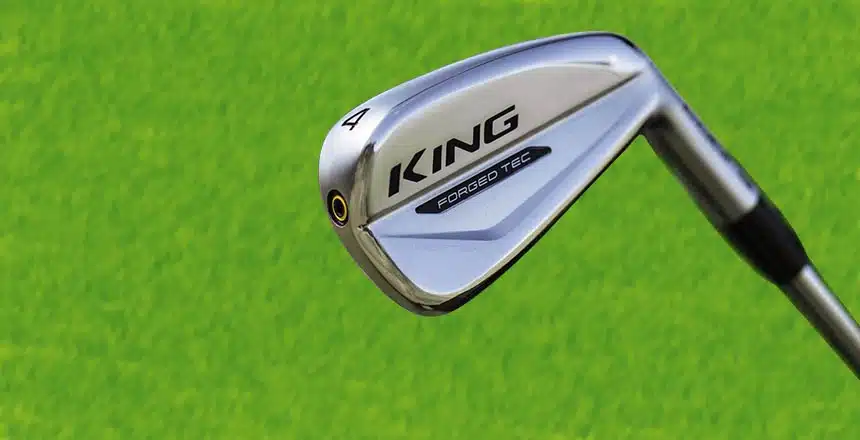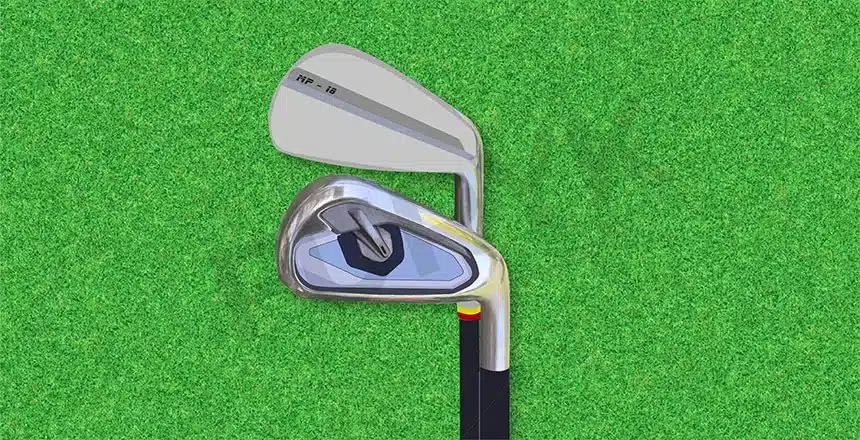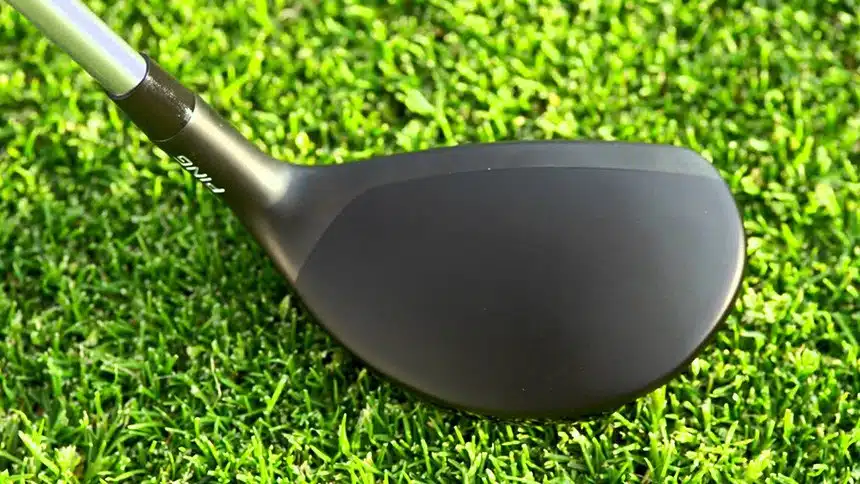More forgiving mallet putter designs are coming up more and more it seems. And these types of golf putters, with their higher MOI, minimize the repercussions of mis-hits. But then you have blade-style traditional putters too, which offer their own charm in the form of more accuracy and control on those longer putts.
So what’s it going to be for you – blade vs mallet putter? This is the ultimate comparison!
Those inclined toward choosing the mallet version, since most amateur and now even pro-level golfers are doing the same, have valid reasons to do so. Such as more availability/options, different hosel/neck configurations, suited for a broader range of putting stroke techniques, and more.
But the same can be said about the blade design, that those who choose blade over mallet provide their own compelling reasons for it.
So why don’t we find out what each putter is capable of achieving and how? And then I’m also going to talk about the major differences between the two. So you can find out what is the best putter FOR YOU!
In This Post
Mallet Putters – What Are They?
In comparison to blade putters, a mallet-style putter is larger. The shaft here is either at the center or attaches at the heel.
Back when mallet putters were first introduced, their shape was more of a semi-circle but that’s not the case anymore. Modern designs now look like spiders, squares, and fangs coming out from the backside of the head. And these heads just keep getting more customizable and even larger.
But won’t that make the putter heavier too? Well, not necessarily. The weight differs from one putter to the next, much like blade putters. In fact, both mallet and blade putters could weigh the same. Nonetheless, the primary reason why most golfers choose the former is because of its incredibly forgiving properties.
Mallet putters are large, right? So this creates a larger sweet spot, which means mis-hits or off-center strikes still send the golf ball rolling toward the desired target.
Also, the putter type is hugely based on what your putting stroke is. So those who opt for mallet putters most likely have a straight-back-straight-through swing style. At such times, the mallet structure, due to its larger clubhead, ensures that the ball stays true to the path. And isn’t that why most of the heavy putters well-known for holding a true line to the hole have a mallet design!
So if your putting struggles include not getting the alignment right, a mallet putter is for you. Even the alignment markings or lines, in the case of mallet, are longer, hence easier to follow/use than traditional blades.
What’s So Great About Mallet Putters?
- They’re ideal for straight-back-straight-through putting stroke.
- They feature easier, longer alignment aid.
- They’re super, super forgiving than blade putters.
- They can be customized easily.
- They make maximizing distance control a more attainable goal.
- They come in various designs, including center-shafted.
What’s NOT So Great About Mallet Putters?
- Not suitable for the arc-style stroke.
- Not the best performance on those speedy greens.
Blade Putters – What Are They?
Ask any seasoned golfer and he/she will tell you that traditional blade putters have their own grace and glamor. The original blade design was completely flat, so you could use the putter from both the sides.
But modern-day blade putters are different in that they’re larger. Although the head obviously doesn’t extend too far back, like with its mallet counterpart.
Now blade putters are often found in the golf bags of Tour players. And why that is it’s because the blade-style provides better control and feel. Mallet doesn’t do that.
Furthermore, if your putting stroke is arc-style, then only a blade putter will do. In such a scenario, while swinging back, you get the wonderful opportunity to open the face a little before releasing and closing it through impact.
And even with blade putters, you can select between a clubface insert (which offers extra control and feel just by the way) or a solid CNC-milled clubface. The same applies to mallet-designed putters too.
What’s So Great About Blade Putters?
- They’re perfect for the arc putting stroke.
- They pave the way for consistent impact.
- They’re better than mallet putters as far as control and feel are concerned.
- Their performance on fast greens is the most impressive.
- They infuse more precision into putting performance.
What’s NOT So Great About Blade Putters?
- Not the easiest when it comes to correct alignment.
- Not the most forgiving putter design.
So now you know both blade vs mallet putter pros and cons.
Blade Putter vs. Mallet Putter – How Do They Differ, Performance-Wise?
Do the differences between these two most commonly used putters amount to almost nothing? And what about factors like feel, control, looks, etc.? Do these automatically imply better performance? With regards to putter design and innovation, technological advancements have taken center-stage (TaylorMade putters are proof).
Blade putters, known as the traditional or timeless golf putters, focus more on precision, feel, and control (preferred by Tour-grade players). However, manufacturers have now somehow found innovative methods to incorporate forgiveness and consistency as well into the mix.
A good example would be Odyssey’s White Hot series of putters. The White Hot OG model, after all, is a part of some of the best putters of ALL time.
As for mallet-style putters, these are built with a larger head that maximizes mis-hit forgiveness. Hence, forgiveness is prioritized more than accuracy, control, and feel (therefore, better suited for beginners). Although there are quite a few exceptions that take care of pretty much everything.
So it might ultimately boil down to your putting stroke style – straight-back-straight-through (mallet) or arc (blade).
FAQs – Blade or Mallet Putter?
Do Pros Choose Blade or Mallet Putters?
Many golfing pros and champions (more than you’d expect actually) use mallet-style putters, quite surprisingly. The list includes Jon Rahm, Cameron Smith, Ian Poulter, Keith Mitchell, and it goes on.
And those (such as Patrick Reed, Bryson DeChambeau, Rickie Fowler, Zac Blair, Kristoffer Ventura, and more) who prefer the traditional blade design mainly do so for a better feel since they don’t tend to struggle with factors like consistency and alignment.
Although there are players like Adam Hadwin, John Huh, and Matt Kuchar who use the “wide” blade design, which consists of the traditional blade shape but is heavier, larger, and thus more forgiving (pretty much like mallet-style putters).
Here’s the complete list of top-50 golfers and their choice of putters.
Should I Pick A Blade or Mallet Putter?
So it depends on what your putting stroke is. Straight-back-straight-through? Then choose a mallet-style putter. On the other hand, those with an arc putting style go for the best blade putters.
If you keep this aside and just look at how putter technology has evolved over the years, the mallet design seems like the better option for all types of golfers, especially average players. But the fact that even low-handicap golfers are now switching from blade to mallet says a lot about how much more appealing the latter is becoming.
Are Mallet Putters More Forgiving?
The larger size of the clubhead is what makes mallet putters so much more forgiving in comparison to the blade. A larger head means a more expansive sweet spot, thus no need to be so precise for hitting a solid putt. Meaning your putt can still be great with off-center contact when using a mallet-style putter.
Does Putting Stroke Matter When Choosing Between Blade and Mallet Putter?
Mallet putters are better suited for the straight-back-straight-through putting stroke. While arc strokes pair up with the blade design better since, in this case, you can open (wide) the putter face and then close it through impact.
Blade or Mallet Putter for Beginner, What Is Better?
More consistent distance control and a larger sweet spot, hence higher chances of putts rolling in the direction of the hole – that’s the kind of experience beginners not only expect but also get with mallet-designed putters.
But then blade putters are not a bad choice if you care enough to learn how to properly use it. Even so, the best mallet putters have proven to bring about more success for a beginner.
So Are You Using the Right Putter?
You aren’t if not enough of those putts of yours are sinking. Do they come up short? Do they seem to be all over the place? Then it’s likely you’re using the wrong putter. Or maybe there’s an unresolved issue with your putting stroke.
The overall conclusion is that mallet putters are more commonly spotted. They’re more forgiving, easier to hit, and offer excellent distance control. But blade putters have their own niche carved out for them since you can rely on them heavily for feel.






I’m just curious as to approximately how many putters Jim Furyk has owned and or used in his life!?
Quite a collection.